Child care is a critical component of a modern and thriving economy. High-quality and affordable care is essential for parents to stay in the workforce. Businesses across all sectors need workers who have a safe and reliable place for their children. The coronavirus pandemic highlighted how important child care is and the complex challenges the system faces across the country. Child care businesses operate on narrow profit margins, often struggle to pay fair wages, and have high staff turnover. However, this long-undervalued industry played a key role in reopening, allowing businesses to recruit and retain workers.
Even before the pandemic, Montana lacked enough child care for years. In 2017, Montana ranked in the bottom five states for access, meeting only 41 percent of the demand.[1] Affordability has also been a problem as families struggled to pay for child care for years. Families paid between $7,900 and $9,100 for child care in 2016, more than the cost of in-state tuition at a four-year public college.[1] The affordability situation has not improved. Today families pay between $8,400 and $9,500 for child care.[2]
Over the past three years, Montana has received unprecedented levels of federal funding (nearly $200 million) to stabilize and support the child care system.[3] Using federal relief funds, Montana expanded eligibility for child care scholarships, lowered the copayments parents pay for a child care scholarship, provided stipends to child care workers, and distributed grants to stabilize and expand Montana’s child care capacity.[4],[5] As federal relief money runs out, many of the policy changes that supported child care businesses and families will discontinue without state investment. For example, eligibility for the child care scholarship program is dropping back down to pre-pandemic levels starting in January 2023, and families who do still qualify will begin paying hundreds more per month toward a copayment.[6],[7]
Access: Many Families Cannot Find Licensed Child Care Providers
More than 71,000 children younger than age 6 call Montana home, and 70 percent of these children have all parents in the workforce.[8],[9] Children younger than age 6, particularly those with all parents working, likely need some type of child care before attending school. Additionally, 93,500 school-age children in Montana (age 6 through 12) may also need care before or after school.[8]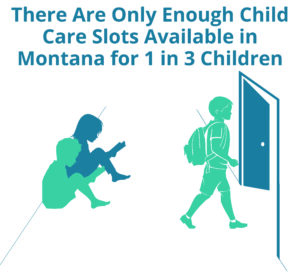
In 2022, Montana had 1,187 regulated child care facilities providing 22,931 slots for children age birth to 12.[10],[11] Head Start programs in Montana also provide care to young children. Head Start programs can be licensed by the state, and those programs are included in the state-reported data. Other programs are not state-licensed but do meet health and safety standards set at the federal level. Head Start served 3,917 children in Montana in 2022.[12]
The current supply of regulated child care does not meet the demand. In 2022, there was one child care slot for every three children younger than age 6.[13] Another way to measure the number of children needing care is to count only those children with all parents working. Using this measure, the current number of regulated child care slots meets about half of the children needing care.[14] It is important to use both measures of demand to assess the current child care supply for two reasons: 1) the number of parents working is only an estimate provided by a survey from the U.S. Census Bureau, and 2) more parents may choose to work if there were better access to care.
While all areas of Montana face a lack of child care supply, the issue is more pronounced in rural and tribal communities. In Montana, five counties lack even a single regulated child care provider: Carter, Fallon, Petroleum, Treasure, and Wibaux.[10] On average, rural counties have child care for 31 percent of children with all parents working, compared to 43 percent for moderately rural counties and 47 percent in the least rural counties.[15] Six tribal nations within Montana operate a tribal Head Start program that collectively enrolled 1,094 children in 2022.[12] On average, tribal Head Start programs provide care for 41 percent of children younger than age 6 with all parents working who live on one of the American Indian reservations with a tribal Head Start program.[12],[16] Through Head Start, tribal nations provide critical access to early childhood education for families living in reservation communities, offering evidence-based and culturally relevant early education to a group that has faced generations of limited access to social and economic resources.[17] Across all of Montana, children of color make up about half of Head Start enrollment (48 percent compared to 24 percent of the population in Montana), underscoring the importance of Head Start for historically marginalized communities.[18],[19]
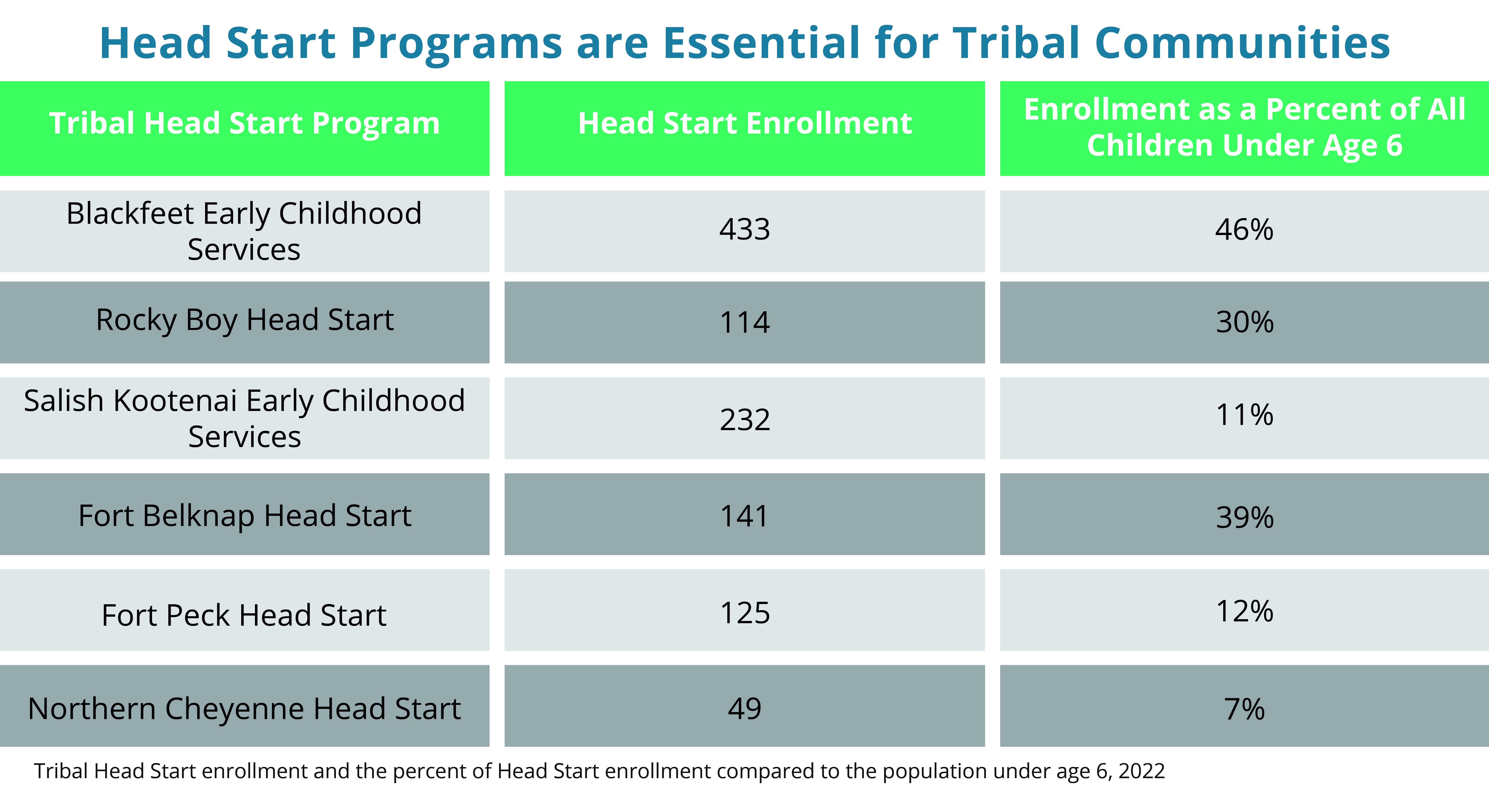 Families in need of child care for infants and toddlers (age birth to 1) find even fewer options. The current supply meets 39 percent of the demand for infants and toddlers with all parents working.[20] Child care providers spend more when caring for infants and toddlers to cover higher staffing needs and additional supplies. The higher cost burden dissuades many providers from offering infant and toddler slots, leaving families of young children to navigate waitlists or make difficult decisions on how or if to return to work.
Families in need of child care for infants and toddlers (age birth to 1) find even fewer options. The current supply meets 39 percent of the demand for infants and toddlers with all parents working.[20] Child care providers spend more when caring for infants and toddlers to cover higher staffing needs and additional supplies. The higher cost burden dissuades many providers from offering infant and toddler slots, leaving families of young children to navigate waitlists or make difficult decisions on how or if to return to work.
Access: School-age Programs Are Limited for Families
The shortfall worsens even further when adding in school-age children who need before or after-school care. Comprehensive data on all school-age programs is lacking in Montana. The Montana Afterschool Alliance compiles a database of afterschool programs and estimated more than 45,000 Montana students were enrolled in an afterschool program during the 2020 school year.[21] More Montana students would enroll in an afterschool program if one were available to them.[22] Parents report that cost and lack of transportation are the top two barriers to finding out-of-school care for their children. School-age children are more likely to have all parents working (75 percent), underscoring the importance of school-age care for parents to stay in the workforce.[9] Expanding school-age care also provides an opportunity to support the state’s future workforce. Afterschool and summer programs can help students gain new skills and learn about new interests or professions.[23]
The numbers are clear; the current supply of child care does not meet the needs of Montana families. Parents unable to find a regulated child care facility for their children may turn to care that does not provide the same reliability or health and safety standards. Parents may also be forced to drop out of the workforce without access to care. This has been particularly evident during the pandemic, where mothers of young children left the labor force at a higher rate than women without children.[24]
Labor force participation for mothers with young children dropped 7 percentage points between 2019 and 2020 in the three-state region of Montana, North Dakota, and South Dakota.[26] Inadequate child care also impacts businesses. When workers cannot access child care, businesses experience lower productivity and struggle to recruit and retain workers. A recent analysis estimates that inadequate child care causes Montana businesses to lose $55 million while parents miss out on $145 million in wages.[25]
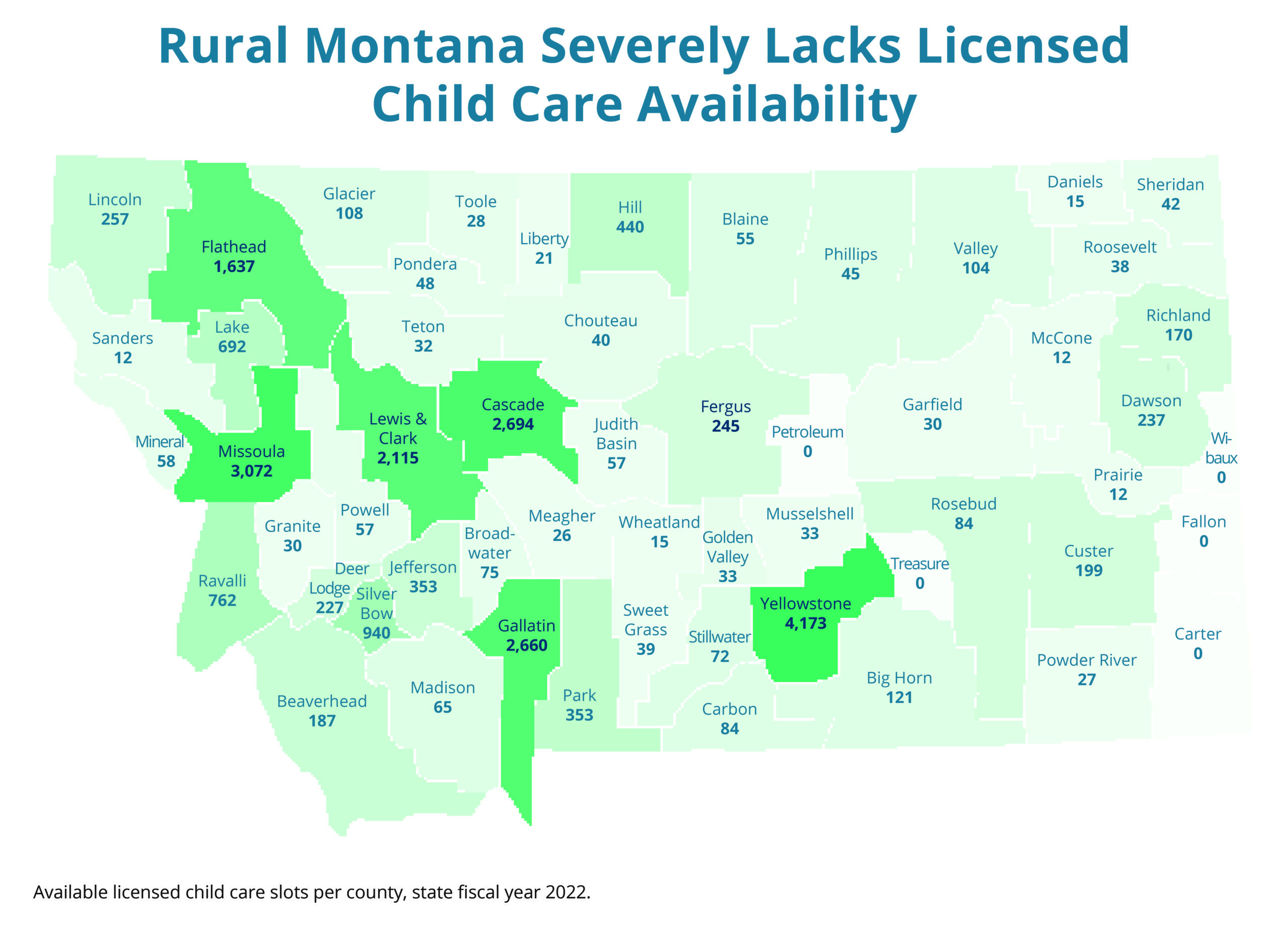
Quality: Not All Available Child Care Is High Quality
High-quality child care provides a safe and nurturing environment for children, involves their families, and creates a supportive environment for workers. Licensed facilities meet basic health and safety standards set by the state, establishing a baseline standard of care. Little is known about unlicensed facilities; however, they exist in Montana. The U.S. Economic Census records businesses that report income as child daycare services. More than 600 businesses report income from child care than are regulated with the state.[26]
Child care facilities that provide high-quality care go above and beyond licensing requirements. Providers in Montana can participate in a voluntary quality rating and improvement system (QRIS, also called “Best Beginnings STARS to Quality”). Providers advance through five rating levels as they demonstrate improvement in employee qualifications, training, and professional development; supportive learning environments for children; and engagement with families. A provider at QRIS level two begins receiving financial incentives and an increased scholarship reimbursement to use for continued improvement.
The majority of child care providers (82 percent) do not participate and receive a quality rating.[10] Child care providers must invest time and resources to offer high-quality programs, and it can take a year or more to move through one QRIS level. Montana needs solutions that encourage more providers to participate in QRIS in addition to ongoing support for current high-quality providers to maintain high standards of care.
Affordability: Parents Often Cannot Afford Child Care and Child Care Businesses Struggle to Stay Open
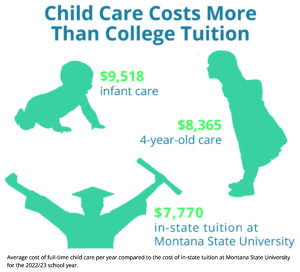 Montana families struggle to afford child care. On average, families pay $9,518 per year for infant care and $8,365 per year for 4-year-old care, making child care more expensive than college tuition and fees at a four-year public college.[2],[27] This means a household making $57,700 spends 16 percent of its income on infant child care.[28]
Montana families struggle to afford child care. On average, families pay $9,518 per year for infant care and $8,365 per year for 4-year-old care, making child care more expensive than college tuition and fees at a four-year public college.[2],[27] This means a household making $57,700 spends 16 percent of its income on infant child care.[28] ![]() The Best Beginnings Child Care Scholarship provides money towards these costs for families with lower incomes. In 2022, 6,622 children received a child care scholarship.[29] However, more eligible children could benefit from the program than are currently participating. Estimates from the U.S. Census Bureau show that 21,500 children live below the income guideline for Best Beginnings eligibility (less than 150 percent of the federal poverty level, or less than $34,550 per year for a family of three).[30],
The Best Beginnings Child Care Scholarship provides money towards these costs for families with lower incomes. In 2022, 6,622 children received a child care scholarship.[29] However, more eligible children could benefit from the program than are currently participating. Estimates from the U.S. Census Bureau show that 21,500 children live below the income guideline for Best Beginnings eligibility (less than 150 percent of the federal poverty level, or less than $34,550 per year for a family of three).[30],
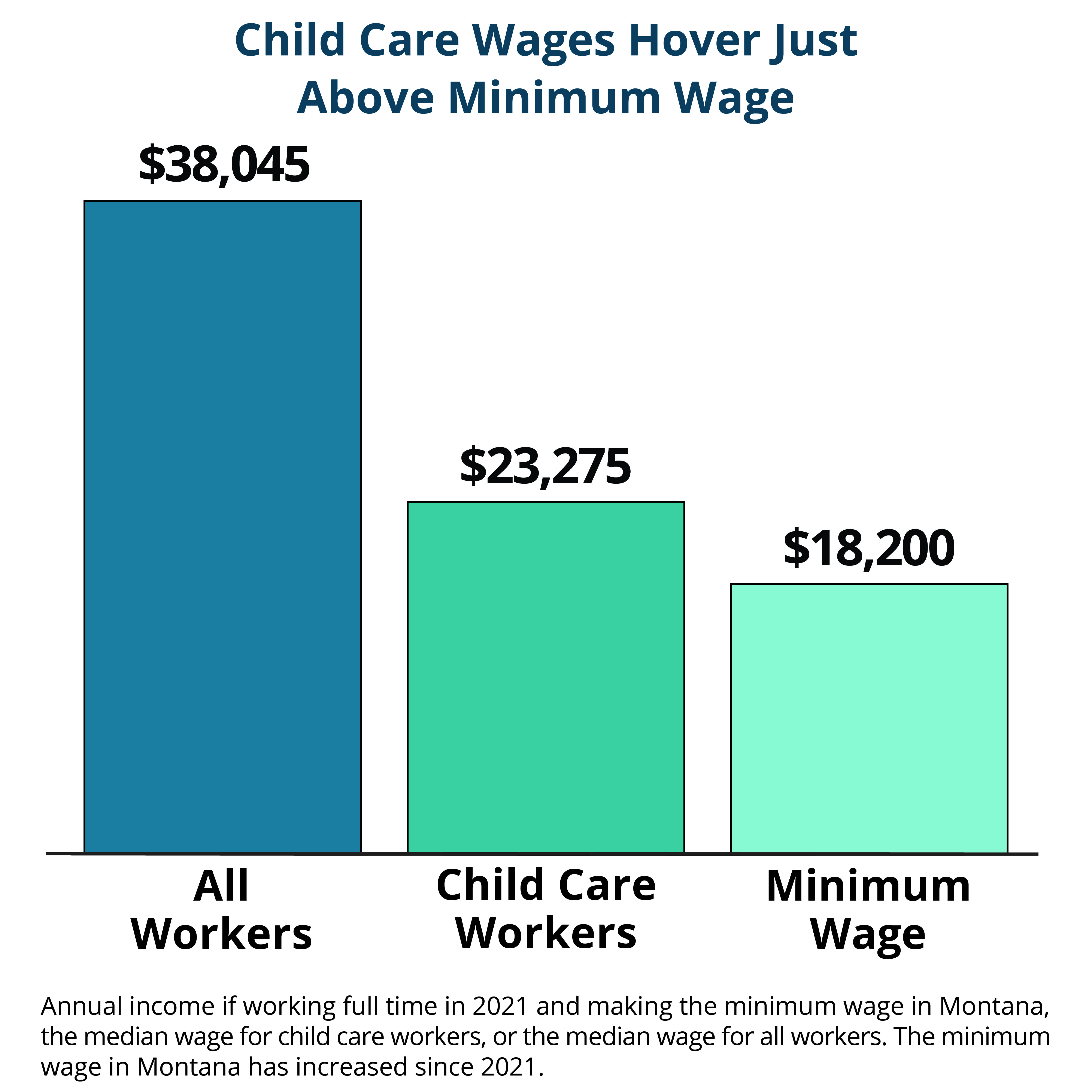
Child care businesses must balance the true cost of providing high-quality care with what parents can afford. Because![]() of this, many child care businesses operate on narrow margins and often cannot pay employees a fair wage. Employee wages and benefits make up more than half the cost for most child care businesses (68 percent for infants and 59 percent for toddlers and preschool-age), with other expenses going toward rent and utilities, administrative costs, and classroom materials.[32]
of this, many child care businesses operate on narrow margins and often cannot pay employees a fair wage. Employee wages and benefits make up more than half the cost for most child care businesses (68 percent for infants and 59 percent for toddlers and preschool-age), with other expenses going toward rent and utilities, administrative costs, and classroom materials.[32]
Low wages for child care workers lead to staffing instability, making it challenging for child care businesses to retain workers and remain open. In Montana, 4,380 individuals work in the early childhood field.[33] Child care workers are predominately female (84 percent) and more diverse compared to all workers (15 percent of child care workers are workers of color compared to 11 percent of all workers).[34] In Montana, the median wage for child care workers was $11.19 an hour in 2021, which means making $23,275 per year if working full-time.[35] This is barely hovering above the poverty level for a family of three.[31] Child care workers make less than half the wage of a kindergarten teacher, even though 24 percent of child care workers in Montana have a bachelor’s degree or higher.[33],[36]
The child care system in Montana is in dire need of solutions that consider both the affordability for parents and support for child care businesses that continue to play a critical role in Montana’s economic recovery.
Recommendations
Montana lacks strong state investments in the child care and early childhood education system. With a state surplus of nearly $2 billion, now is the time to invest in a child care system that works for children, parents, and businesses. Specific recommendations include:
Expand and improve the Best Beginnings Scholarship program to help more Montana families afford child care.
Support the child care workforce and child care providers as business owners.
Increase access to child care across the state, particularly in areas with significant child care shortfalls.
[1] Watson, A., “Childcare in Montana,“ Department of Labor & Industry, 2018.
[2] Economic Policy Institute, “The cost of child care in Montana,” accessed on Nov. 30, 2022.
[3] Federal relief funds include: The Coronavirus Aid, Relief, and Economic Security Act (CARES) of 2020 ($10 million plus an addition $50 million Governor Bullock directed to child care), Coronavirus Response and Relief Supplemental Appropriations Act (CRRSA) of 2021 ($28 million to the state and $6.8 million to tribal nations within Montana), and American Rescue Plan Act (ARPA) of 2021 ($111 million to the state and $28.6 million to tribal nations within Montana).
[4] Montana Department of Public Health and Human Services, “60-day report of the Coronavirus Response and Relief Supplemental Appropriations Act, letter sent to Ellen Wheatley on Feb. 25, 2021,” on file with author.
[5] Montana Department of Public Health and Human Services, “ARPA Funding Summary Table – Period of Performance End Date 9/8/2022,” on file with author.
[6] Montana Department of Public Health and Human Services, Early Childhood Services Bureau, “Update: Best Beginnings Covid Payment Policies Memo, 10/17/2022,” on file with author.
[7] Using federal relief funds, copayments were capped at $10 per month. With the sliding fee scale back in place, a single parent with one child making $27,500 per year will now pay $320 per month for a copayment, equal to an extra $3,840 per year for child care. Montana Department of Public Health and Human Services, “Montana Best Beginnings Child Care Scholarship Child Care Sliding Fee Scale, Effective 04-01-2022.”
[8] KIDS COUNT Data Center, Child population by single year of age in Montana, 2021.
[9] U.S. Census Bureau, “Age of Own Children Under 18 Years in Families and Subfamilies by Living Arrangements by Employment Status of Parents, American Community Survey 1-Year Estimates, Table B23008, 2021,” accessed on Nov. 30, 2022.
[10] KIDS COUNT Data Center, Licensed child care facilities by STAR level in Montana, State Fiscal Year 2022.
[11] KIDS COUNT Data Center, Licensed child care capacity by STAR level in Montana, State Fiscal Year 2022.
[12] Office of Head Start, Head Start Program Information Report, 2022, on file with author.
[13] KIDS COUNT Data Center, Percent of all children under 6 that can be served by licensed child care capacity in Montana, State Fiscal Year 2022.
[14] KIDS COUNT Data Center, Percent of children under 6 with all parents working that can be served by licensed child care capacity in Montana, State Fiscal Year 2022.
[15] County designation is based on the Center for American Progress designations of least rural, moderately rural, and most rural. Designations are assigned using the U.S. Department of Agriculture’s Economic Research Service codes for rural-urban continuum. The Montana Early Childhood Needs Assessment identified these designations in Montana on page 18. Least rural counties include: Cascade, Custer, Dawson, Deer Lodge, Fergus, Gallatin, Glacier, Hill, Lewis and Clark, Missoula, Park, Richland, Roosevelt, Silver Bow, Toole, Yellowstone. Moderately rural counties include Beaverhead, Big Horn, Flathead, Lake, Lincoln, Pondera, Powell, Ravalli, Valley. All other counties assigned to most rural. Smith, K., “Montana’s Early Childhood System: A Comprehensive Statewide Needs Assessment,” Sept. 2019. Percentages are calculated as average among counties for: KIDS COUNT Data Center, Percent of children under 6 with all parents working that can be served by licensed child care capacity in Montana.
[16] Children needing care estimates (denominator of the percent) are from Census estimates at the American Indian Reservation geography. U.S. Census Bureau, “Age of Own Children Under 18 Years in Families and Subfamilies by Living Arrangements by Employment Status of Parents, American Community Survey 5-Year Estimates, Table B23008, 2017-2021” accessed on Dec. 9, 2022.
[17] Bipartisan Policy Center, “Data and Funding Gaps in Tribal Early Care and Education,” Apr. 2021.
[18] Children of color include those identifying as American Indian or Alaska Native, Asian, Black or African American, Native Hawaiian or other Pacific Islander, Biracial/Multi-racial, other, or Hispanic. Data from: Office of Head Start, Head Start Program Information Report.
[19] U.S. Census Bureau, Population Estimates Program, Annual county resident population by single year of age (0-84,85+), sex, race (11), and Hispanic origin for April 1, 2020 (estimates base) and July 1, 2020-July 1, 2021 for Montana, on file with author.
[20] KIDS COUNT Data Center, Percent of infants and toddlers with all parents working that can be served by licensed child care in Montana, State Fiscal Year 2022
[21] Montana Afterschool Alliance, “Snapshot of afterschool in Montana,” Oct. 2020.
[22] Afterschool Alliance, Montana After 3pm, accessed on Dec. 1, 2022.
[23] Afterschool Alliance, “Building Workforce Skills in Afterschool,” Nov. 2017.
[24] Boesch, T., Grunewald, R., Nunn, R., Palmer, V., “Pandemic pushes mothers of young children out of the labor force,” Federal Reserve Bank of Minneapolis, Feb. 2021.
[25] Dillon, T., Baldridge, J., Sonora, R., Grunewald, R., “Lost Possibilities: The Impacts of Inadequate Child Care on Montana’s Families, Employers and Economy,” Bureau of Business and Economic Research, University of Montana, Sept. 2020.
[26] Data includes businesses that report income as child day care services under NAICS code 6244. Employers, Individual Proprietorship, and Partnerships are all included. U.S. Census Bureau, “Nonemployer Statistics for the U.S., States, Counties, Metropolitan Areas, and Combined Statistical Areas; and by Legal Form of Organization and Sales, Value of Shipments, or Revenue, U.S. Economic Annual Survey, 2019,” accessed on Nov. 30, 2022. U.S. Census Bureau, “County Business Patterns by Legal Form of Organization and Employment Size Class for the U.S., States, and Selected Geographies, U.S. Economic Annual Survey, 2019,” accessed on Nov. 30, 2022. Licensed facilities in Montana in 2019 is from: KIDS COUNT Data Center, Licensed child care facilities by STAR level in Montana. A total of 1,976 child care businesses are identified in the Economic Census Data, compared to 1,336 regulated by the state.
[27] Estimated cost for an undergraduate, resident student is $7,726 for the academic year and includes tuition and fees. Montana State University, “Estimated Expenses, 2022/2023 Montana State University Undergraduate Cost of Attendance,” accessed on Dec. 1, 2022.
[28] The median income for households in Montana in 2020 is $57,730. KIDS COUNT Data Center, Median household income in Montana, 2020.
[29] KIDS COUNT Data Center, Children receiving Best Beginnings Child Care Scholarship in Montana, State Fiscal Year 2022.
[30] U.S. Census Bureau, “Age by Ratio of Income to Poverty Level in the Past 12 Months, American Community Survey 5-Year Estimates, Table B17024, 2017-2021,” accessed on Dec. 8, 2022. Population estimate of 71,447 children age birth to five are multiplied by poverty percentage.
[31] 2022 Poverty Guidelines for the 48 Contiguous States and the District of Columbia
[32] Estimates are for center-based child care. Center for American Progress, “Where Does Your Child Care Dollar Go?,” Feb. 2018.
[33] Center for the Study of Child Care Employment, “Early Childhood Workforce Index 2020,” Feb. 2021.
[34] Center for Economic and Policy Research, CEPR’s Analysis of American Community Survey, 2014-2018 5-Year Estimates, Apr. 9,2020, on file with author.
[35] U.S. Bureau of Labor Statistics, Occupational Employment and Wage Statistics, “May 2021 State Occupational Employment and Wage Estimates Montana,” accessed on Dec. 1, 2022.
[36] Montana Early Childhood Project, “Registry Demographics,” Jan. 2020-Dec. 2020, registry data was a special request and is on file with author.

MBPC is a nonprofit organization focused on providing credible and timely research and analysis on budget, tax, and economic issues that impact low- and moderate-income Montana families.